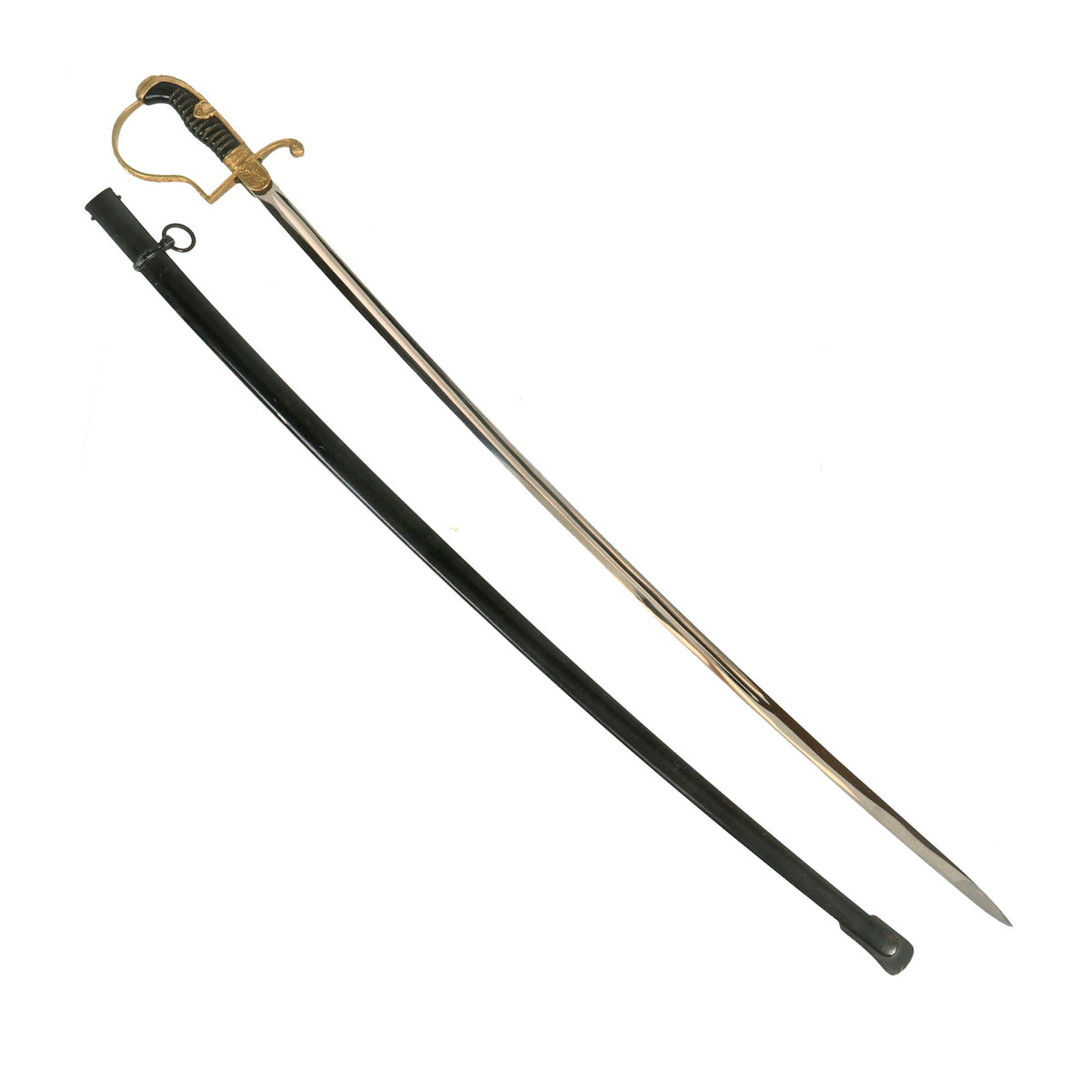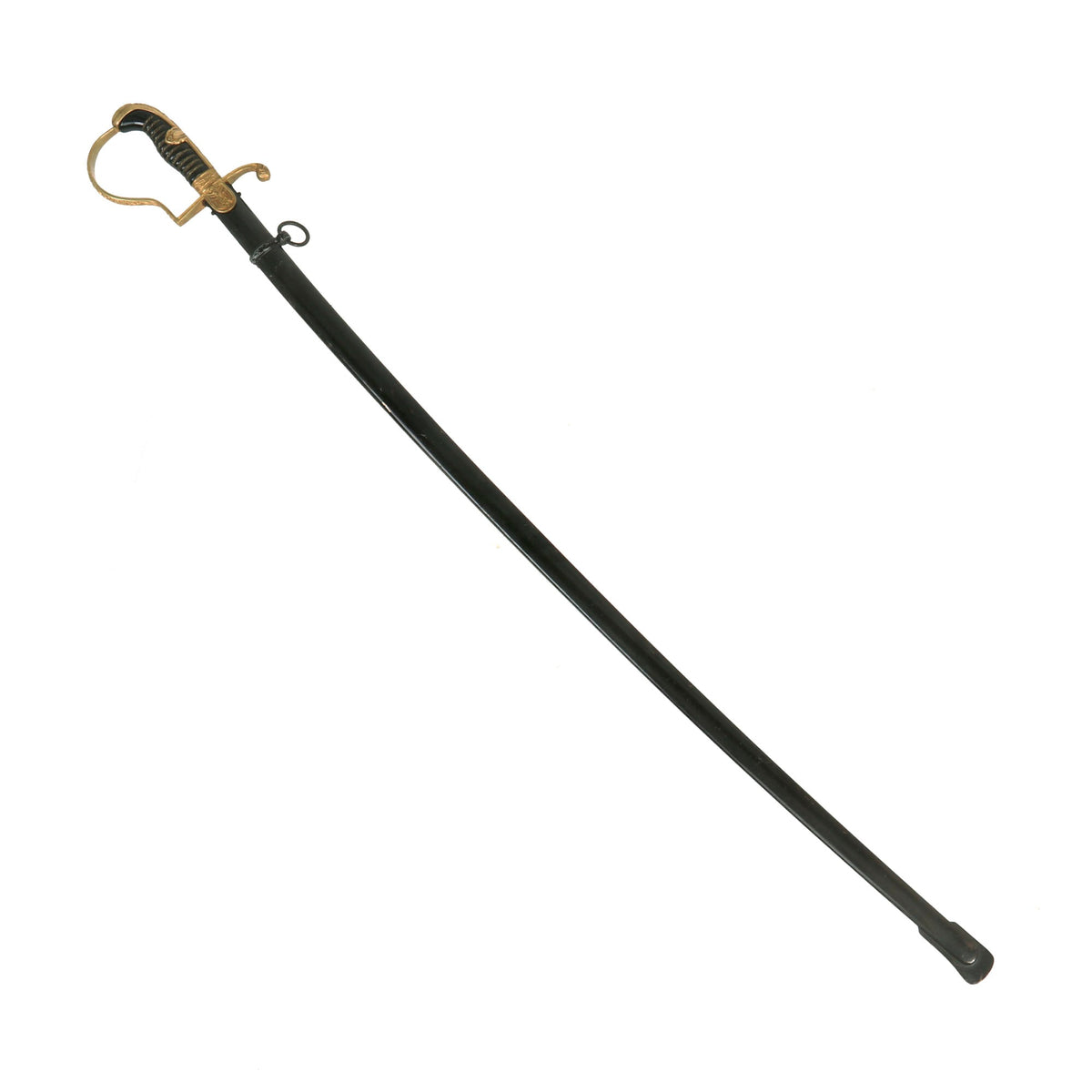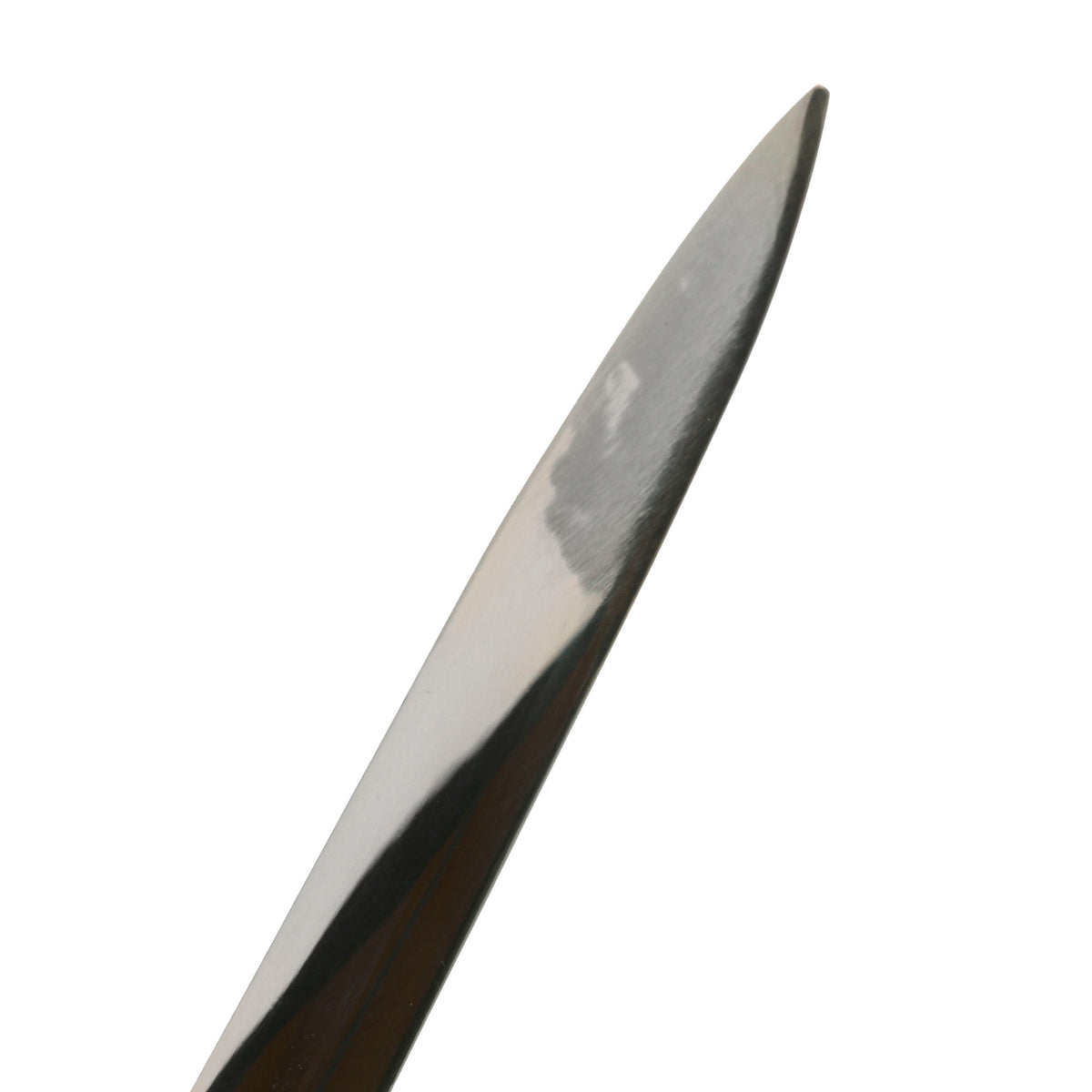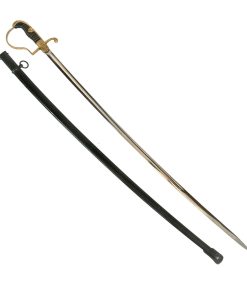Original German WWII Army Officer Dove Head Sword by WKC Waffenfabrik with Scabbard Original Items
$ 650,00 $ 195,00
Original Item: Only One Available. This Army Dove Head Sword is an excellent example, produced by the renowned Solingen-based firm of WKC Waffenfabrik, previously Weyersberg Kirschbaum & Cie. It comes complete with its original black enamel steel scabbard, which is also in great shape.
The hilt on this example is the classic gilt brass alloy, not the later war plated aluminum. Unlike most that we see, it still retains a good amount amount of the original gilding in the recesses, while there is wear to the raised portions. There is no major patination or oxidation on the raised areas, so it was definitely well taken care of. Really a lovely looking hilt, with all of the details still there. The dove head on this pattern is plain, while the back strap shows a large rounded cross, with oak leaves below and laurel leaves closer to the pommel, a common decoration used on German ceremonial edged weapons. The “flat” P guard bears the famous “oak leaves and acorns” motif, as does the ferrule at the top of the grip. There are lots of hand enhancing and many of the backgrounds have received pebbled decoration.
The chappe/langet features a raised out closed wing Wehrmacht eagle looking to the left, which shows excellent detail to his beak, eye, breast feathering, wing feathering, talons and mobile clutched swas. The areas around the eagle are lightly pebbled, and the reverse langet has a small shield surrounded by a half oak leaf half laurel wreath, where the sword could be monogrammed, which is blank. The grip of this example is a black celluloid over a carved wood base. The celluloid is still in very good condition with no cracking or chipping, though it does show some scuffing. The grip is wrapped with triple sets of twisted wire, the center pair being larger in diameter, which show some level of oxidation, and are just a bit lose in some areas. The entire hilt is still mostly tight on the guard, a rarity with these swords.
The blade is 33 ⅛ inches long, with the original leather blade washer is in place, showing some cracking from age. This blade is of highest quality steel and reflects a mirror with its bright nickel finish. This blade is in excellent condition, with the original nickel plating almost completely retained, which unfortunately makes getting good photographs nearly impossible. There are just a few spots of oxidation, and the edge just has a few tiny dents, with no signs of major use.
The ricasso is stamped with the trademark “Knight’s Helmet” (Ritter-helm) over WKC logo of legendary maker WKC Waffenfabrik GmbH of Solingen. This company is a famous manufacturer of military swords and cutlery in Solingen, Germany – a city famous since the middle ages for its metal-working and craftsmanship in sword making. Unfortunately the chappe/rainguard mostly covers the logo, so we were only able to get a photograph from the side.
Per J. Anthony Carter’s work GERMAN KNIFE AND SWORD MAKERS, the traditional manufacturing of swords at WKC dates back to the year 1774 when the Weyersberg first registered the ”Kings head” as their trademark. Later in 1883 the company merged with the Kirschbaums and the company Weyersberg Kirschbaum & Cie was formed, which continued into the Weimar Period. It then rebranded as W.K.C. Waffenfabrik GmbH, and produced many edged weapons during the NSDAP Period. The company is still in operation today.
The steel scabbard of this example is really in great shape, with no bends or dents that we can feel on the straight shell. It still retains over 90% of the original factory black enamel finish, which shows just a bit of wear and chipping, mostly on the back. There is also a lovely pattern of checking and crazing in the enamel, confirming the age. It still retains both throat screws, the hanger loop, and the slot for hitching up the sword to the belt when indoors.
Overall a great example of a German Army Officer Dove Head sword from a legendary maker, complete with scabbard. Ready to display!
Specifications:
Overall length: 38”
Blade length: 33 ⅛”
Blade Style: Single Edged with Fuller
Guard dimensions: 5″ width x 4 ½” length
Scabbard Length: 34 ⅛”
The German Army (German: Heer, was the land forces component of the Wehrmacht, the German armed forces, from 1935 to 1945. The Wehrmacht also included the Kriegsmarine (Navy) and the Luftwaffe (Air Force). During World War II, a total of about 15 million soldiers served in the German Army, of whom about seven million became casualties. Separate from the army, the Waffen-SS (Armed SS) was a multi-ethnic and multi-national military force of the Third Reich. Growing from three regiments to over 38 divisions during World War II, it served alongside the army but was never formally part of it.
Only 17 months after AH announced publicly the rearmament program, the Army reached its projected goal of 36 divisions. During the autumn of 1937, two more corps were formed. In 1938, four additional corps were formed with the inclusion of the five divisions of the Austrian Army after the Anschluss in March. During the period of its expansion by Adolf AH, the German Army continued to develop concepts pioneered during World War I, combining ground (Heer) and air (Luftwaffe) assets into combined arms teams. Coupled with operational and tactical methods such as encirclements and the “battle of annihilation”, the German military managed quick victories in the two initial years of World War II, prompting the use of the word Blitzkrieg (literally lightning war, meaning lightning-fast war) for the techniques used.
The German Army entered the war with a majority of its infantry formations relying on the horse for transportation. The infantry remained foot soldiers throughout the war; artillery also remained primarily horse-drawn. The motorized formations received much attention in the world press in the opening years of the war, and were cited as the main reason for the success of the German invasions of Poland (September 1939), Norway and Denmark (April 1940), Belgium, France and Netherlands (May 1940), Yugoslavia (April 1941) and the early campaigns in the Soviet Union (June 1941). However their motorized and tank formations accounted for only 20% of the Heer’s capacity at their peak strength.
Fast Shipping with Professional Packaging
Thanks to our longstanding association with UPS FedEx DHL, and other major international carriers, we are able to provide a range of shipping options. Our warehouse staff is expertly trained and will wrap your products according to our exact and precise specifications. Prior to shipping, your goods will be thoroughly examined and securely secured. We ship to thousands clients each day across multiple countries. This shows how we're dedicated to be the largest retailer on the internet. Warehouses and distribution centres can be located throughout Europe as well as the USA.
Note: Orders with more than one item will be assigned a processing date depending on the item.
Before shipping before shipping, we'll conduct a thorough inspection of the items you have ordered. Today, the majority of orders will be delivered within 48 hours. The delivery time will be between 3-7 days.
Returns
The stock is dynamic and we cannot completely manage it because multiple stakeholders are involved, including our factory and warehouse. So the actual stock may alter at any time. It's possible that you may not receive your order once the order has been made.
Our policy is valid for a period of 30 days. If you don't receive the product within 30 days, we are not able to issue a refund or an exchange.
You can only return an item if it is unused and in the same state as the day you received it. You must have the item in its original packaging.
Related products
Uncategorized
Uncategorized
Uncategorized
Uncategorized
Uncategorized
Band of Brothers ORIGINAL GERMAN WWII Le. F.H. 18 10.5cm ARTILLERY PIECE Original Items
Uncategorized
Uncategorized
Uncategorized
Australian WWII Owen MK1 Machine Carbine SMG Custom Fabricated Replica with Sling Original Items
Uncategorized
Uncategorized
Angolan Rebel 1970s era 60mm Inert Display Mortar from Angolan Civil War Original Items
Uncategorized
Uncategorized
Uncategorized
Uncategorized
Uncategorized
Uncategorized
Armored Burgonet Helmet & Polearm from Scottish Castle Leith Hall Circa 1700 Original Items













































































